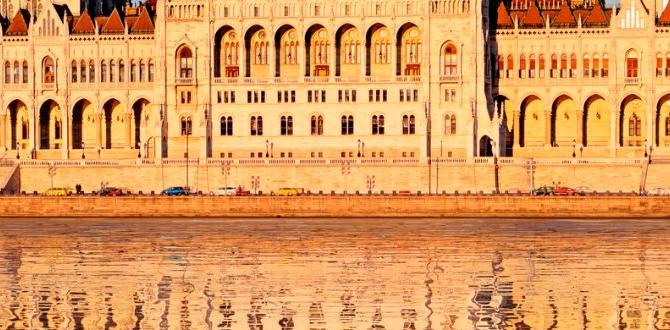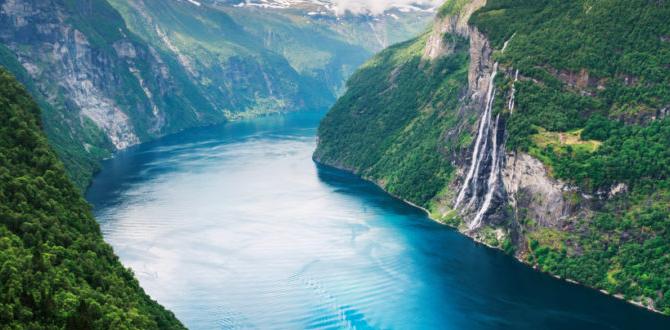Get ready for breathtaking Banff sunrises and sunsets! This guide reveals the best, easy-to-reach spots for incredible photos, even if you’re new to travel photography. We’ll help you capture the magic of the Canadian Rockies during golden hour, making your trip unforgettable.
Banff National Park is truly a photographer’s dream, especially when the sky puts on its morning and evening show. Capturing that perfect sunrise or sunset photo might seem daunting, but it doesn’t have to be. Many of the most stunning views are surprisingly accessible, perfect for beginners or anyone looking for a stress-free experience.
Forget complicated gear or early morning hikes if that’s not your style; we’re focusing on places that deliver big on beauty with minimal fuss. This guide will walk you through the essential spots to witness and photograph the golden hours in Banff, ensuring you come away with memories that last a lifetime and photos you’ll be proud to share.
Capturing the Magic: Your Banff Sunrise & Sunset Photo Adventure
The moments just after dawn and before dusk in Banff are pure, unadulterated magic. The mountains blush with warm light, lakes mirror the vibrant skies, and the entire landscape transforms. As a traveler who loves to document these experiences without the stress, I’ve discovered that Banff offers some incredibly rewarding photo opportunities that are wonderfully beginner-friendly. You don’t need to be a professional photographer to get amazing shots; just a sense of wonder and a willingness to explore. We’ll cover the best spots, what to expect, and a few simple tips to make your experience smooth and memorable.
Why Banff for Sunrise & Sunset Photos?
Banff National Park, nestled in the heart of the Canadian Rockies, is globally renowned for its dramatic mountain scenery, turquoise lakes, and abundant wildlife. This stunning natural beauty is amplified during sunrise and sunset. The low angle of the sun creates long shadows, accentuates the rugged textures of the mountains, and paints the sky with an incredible palette of colors. The reflections in the still waters of lakes like Louise and Moraine add another layer of breathtaking beauty, creating mirror images of the already spectacular vistas.
Planning Your Golden Hour Experience
Timing is everything when it comes to catching the best light. Sunrise happens early, and sunset happens later, so checking the exact times for your visit is crucial.
Sunrise Photography in Banff
Waking up early for a Banff sunrise might seem like a chore, but the reward is immense. The stillness of the morning, the crisp air, and the gradual awakening of the landscape offer a unique and tranquil experience. The light is often soft and diffused, perfect for landscape photography, leading to a serene and stunning final image.
Sunset Photography in Banff
Sunsets in Banff are equally spectacular, often bringing a dramatic flair as the sun dips below the peaks. The vibrant oranges, pinks, and purples that can fill the sky are a photographer’s delight. It’s a fantastic way to end a day of exploring, bringing a beautiful close to your adventures.
Essential Banff Sunrise & Sunset Photo Spots
Here are some of the most accessible and rewarding locations for capturing those golden hour moments in Banff. These spots are chosen for their scenic beauty and relative ease of access, perfect for any traveler.
1. Lake Louise Shoreline
Lake Louise is arguably Banff’s most iconic location, and for good reason. The eastern-facing shoreline offers stunning views of the lake itself, the Victoria Glacier, and the majestic Mount Victoria. During sunrise, the first light hits the glacier and the peaks, casting a warm glow on the snow and rock. The reflections on the calm morning water are simply magical.
Why it’s great for beginners: The shoreline is easily accessible from the Fairmont Chateau Lake Louise. You can walk right up to the edge of the lake and find a spot with a clear view. The path is flat and well-maintained.
Sunrise tip: Arrive at least 30 minutes before official sunrise to catch the pre-dawn glow and the first direct rays. The light hitting the mountain peaks is often the most dramatic part.
Sunset tip: While sunrise is often more photographed here due to the light on the mountains, sunset can still offer beautiful colors reflecting off the lake, often with fewer crowds than midday.
External Link: For current park conditions and advisories, always check the official Parks Canada Banff National Park website before your visit.
2. Moraine Lake (Seasonal Access)
Although access to Moraine Lake is restricted and requires shuttle or bike, the view from the Rockpile is the classic postcard shot of the Valley of the Ten Peaks. The lake’s vibrant turquoise color, fed by glacial meltwater, is stunning against the dramatic backdrop of rugged mountains. The light at sunrise dramatically hits the “Ten Peaks,” making them glow.
Why it’s great for beginners: Once you’re at the lake, the Rockpile viewpoint is a short, paved walk from the parking area. It’s a well-trodden path with incredible payoffs.
Sunrise tip: The sunrise here is legendary. The light creeps over the peaks and illuminates them one by one. The colors of the lake are also incredibly vibrant in the morning light.
Sunset tip: Sunset can be beautiful, but the mountains will be in shadow earlier than at Lake Louise due to their height. The alpenglow on the peaks can still be spectacular, though.
Important Note: Moraine Lake Road is typically open from late May to mid-October. Vehicle access is restricted; Parks Canada encourages the use of shuttles or bicycles to access Moraine Lake. Plan your transportation well in advance. Learn more about Moraine Lake access here.
3. Vermilion Lakes Viewpoint
Located just west of the town of Banff, Vermilion Lakes offers a completely different, yet equally captivating, perspective. These shallow, linear lakes reflect Mount Rundle beautifully, especially during sunrise. The fog that often drifts over the water in the early morning adds an ethereal, atmospheric quality to photographs.
Why it’s great for beginners: This spot is incredibly convenient. You can drive right up to the viewpoint, which features a long boardwalk. Parking is ample, and the views are expansive.
Sunrise tip: This is perhaps one of the easiest and most rewarding sunrise spots. The reflections of Mount Rundle are often unparalleled, especially with morning mist rising from the water.
Sunset tip: Sunset can also catch the warm light on Mount Rundle, and the calm waters often provide excellent reflections. It’s a great option if you prefer not to go too far from town.
4. Peyto Lake Viewpoint (Bow Summit)
Peyto Lake, famous for its wolf-head shape and vivid turquoise waters, offers one of the most iconic panoramic views in Banff. From the Bow Summit viewpoint, the lake stretches out below, framed by the majestic peaks of the Canadian Rockies. While sunrise can be challenging due to the elevation and orientation, sunset colors can be spectacular, and the late afternoon light on the mountains is superb.
Why it’s great for beginners: The main viewpoint is a short, paved walk (about 10-15 minutes) uphill from the parking lot. The view at the top is breathtaking and very accessible.
Sunrise tip: Dawn here can be very cold and the light might not hit the lake directly as effectively as a sunset. However, observing the sky’s colors from such a high vantage point is still a memorable experience.
Sunset tip: Aim for the hour leading up to sunset. The golden light bathes the surrounding peaks, and the lake’s color is still vibrant. The shadows begin to lengthen, adding depth to the landscape.
External Link: Understand the best times to visit Banff and potential crowds by visiting the Travel Alberta website.
5. Emerald Lake (Yoho National Park – a short drive from Banff)
Just a short drive from Banff, within Yoho National Park in British Columbia, Emerald Lake offers a serene and incredibly picturesque setting. The lake’s vibrant green hue, named for its emerald color, is stunning, with snow-capped peaks and dense forests surrounding it. The lodge and cabins add a charming element.
Why it’s great for beginners: The lake is easily accessible from the parking area near the Emerald Lake Lodge. A paved walking path circles much of the lake, offering various vantage points.
Sunrise tip: The eastern-facing mountains reflecting on the lake are spectacular. Morning mist can add an incredible layer of atmosphere, making it feel like you’ve stepped into a painting.
Sunset tip: The western-facing peaks can catch the last rays of the sun, creating beautiful alpenglow. The warm light hitting the surrounding mountains and trees is a photographer’s dream.
6. Cascade Ponds
Closer to the town of Banff, Cascade Ponds offers a very relaxed and accessible location to catch beautiful light. It’s a series of small, shallow ponds with picnic areas and trails, and it provides lovely reflections of Cascade Mountain. It’s less dramatic than the famous lakes but offers a peaceful, intimate setting.
Why it’s great for beginners: Very easy to access by car with plenty of parking. Flat paths make it suitable for everyone. Great for families.
Sunrise tip: The light catching Cascade Mountain is beautiful, and the calm waters reflect the sky. It’s a gentle start to photography for the day.
Sunset tip: A relaxed spot to watch the colors change over Cascade Mountain. The ponds are perfect for capturing reflections of the evening sky.
Tips for the Best Banff Sunrise & Sunset Photos
To make your experience as enjoyable and fruitful as possible, here are some essential tips for capturing those magical moments, keeping comfort and ease in mind.
1. Check the Weather and Light
Conditions in the mountains can change rapidly. A clear sky offers one kind of beauty, while clouds can create dramatic, colorful displays. Use a weather app and a moon/sun calendar to know the exact sunrise and sunset times for your specific date.
Tools:
- Weather Apps (e.g., The Weather Network, AccuWeather)
- Sun Calculator Apps (e.g., PhotoPills, Sun Surveyor)
2. Dress in Layers
Even in summer, mornings and evenings in Banff can be chilly, especially at higher elevations or near the lakes. Wearing layers is key to staying comfortable and being able to enjoy the moments without shivering.
- Base layer: Moisture-wicking fabric
- Mid-layer: Fleece or down jacket
- Outer layer: Waterproof and windproof jacket
- Accessories: Beanie, gloves, and a scarf are essential!
3. Bring a Tripod
For sharper photos, especially in low light conditions, a tripod is invaluable. It helps stabilize your camera, allowing for slower shutter speeds without camera shake. Even a small, portable tripod can make a big difference.
Why it helps:
- Reduces blur from handholding
- Allows for creative effects like silky smooth water
- Lets you use lower ISO for cleaner images
4. Pack Smartly (Beyond Your Camera)
Consider what else you might need for a comfortable outdoor experience. Comfortable footwear is a must for walking to viewpoints. A small backpack can carry your essentials. If you’re traveling with children or need extra comfort and confidence for extended periods, consider discreet and reliable personal care items like adult or child diapers. These can provide peace of mind, allowing you to focus on enjoying the moment rather than worrying about comfort or accidents. Journey Essentials understands these needs for stress-free travel.
- Comfortable walking shoes
- Small backpack
- Water bottle
- Snacks
- Headlamp or flashlight (for navigating in the dark)
- Personal comfort items (e.g., adult/child diapers if needed)
5. Practice Basic Camera Settings
You don’t need to be an expert, but knowing a few basics will improve your shots:
- Aperture: For landscapes, a smaller aperture (higher f-number like f/8 or f/11) keeps more of the scene in focus.
- Shutter Speed: Adjust based on light. With a tripod, you can use slower speeds for brighter images or to blur water. Fast speeds freeze motion.
- ISO: Keep this as low as possible (e.g., 100 or 200) to avoid grainy photos. Increase only if necessary in very low light.
- White Balance: ‘Daylight’ or ‘Cloudy’ often works well, or you can set it manually. RAW files allow for easier adjustments later.
Table: Beginner Camera Settings for Sunrise/Sunset
| Scenario/Goal | Aperture (f-stop) | Shutter Speed | ISO | Notes |
|---|---|---|---|---|
| General Landscape (sharp focus throughout) | f/8 – f/11 | 1/60s – 1/250s (adjust for light) | 100-200 | Use a tripod for slower speeds if needed. |
| Silky Water Effect | f/11 – f/16 | 1 second+ (experiment!) | 100 | Essential to use a tripod. ND filter might be useful. |
| Capturing Bright Color (minimal blur) | f/8 | 1/125s | 100-400 (if needed) | Handheld possible, though tripod is best. |
6. Arrive Early, Leave a Little Late
The “golden hour” is more than just the exact moment of sunrise or sunset. The soft, warm light often begins 30-60 minutes before the sun crests the horizon and lasts for a similar period after it dips below. Give yourself ample time to get to your chosen spot, set up, and enjoy the entire spectacle.
7. Protect Your Gear
If you’re shooting in challenging conditions (e.g., near waterfalls or during light rain), consider a rain cover for your camera. Condensation can also be an issue when moving from a cold exterior to a warm interior, so let your gear acclimatize in its bag before opening it.
Beyond Photography: Enjoying the Moment
While capturing stunning photos is a great goal, remember to also soak in the unparalleled beauty of Banff. Sometimes, the best way to experience a sunrise or sunset is to put the camera down for a few minutes and simply be present. The feeling of the cool mountain air, the sounds of nature, and the incredible visual display are gifts in themselves. Don’t let the pursuit of the perfect shot detract from the overall experience.
Frequently Asked Questions
Q1: What is the best time of year for sunrise and sunset photos in Banff?
A1: While Banff is stunning year-round, fall (September-October) offers beautiful foliage colors with crisp light. Winter (November-March) provides dramatic snowy landscapes and unique light, though access can be more challenging. Summer (June-August) has longer daylight hours but can be busier. Spring (April-May) is a transition period with melting snow and unpredictable weather, but fewer crowds.
Q2: Do I need a Parks Canada Discovery Pass?
A2: Yes, a Parks Canada Discovery Pass is required to enter Banff National Park. You can purchase it online, at park gates, or at visitor centres. It covers entry to all Parks Canada places for a year. You can learn more on the Parks Canada website for information on passes.
Q3: Are these photo spots accessible for people with mobility issues?
A3: Many spots, like the Lake Louise shoreline and Vermilion Lakes, have accessible pathways. However, some viewpoints, like Peyto Lake, involve uphill walks on paved trails that might be challenging. Always check specific accessibility information for your chosen location.
Q4: What if I forget some essential gear, like extra batteries?
A4: You can typically purchase camera batteries, memory cards, and other accessories in the town of Banff. However, selection might be limited, and prices higher than what you’d find at home. It’s always best to pack essentials beforehand if possible.





